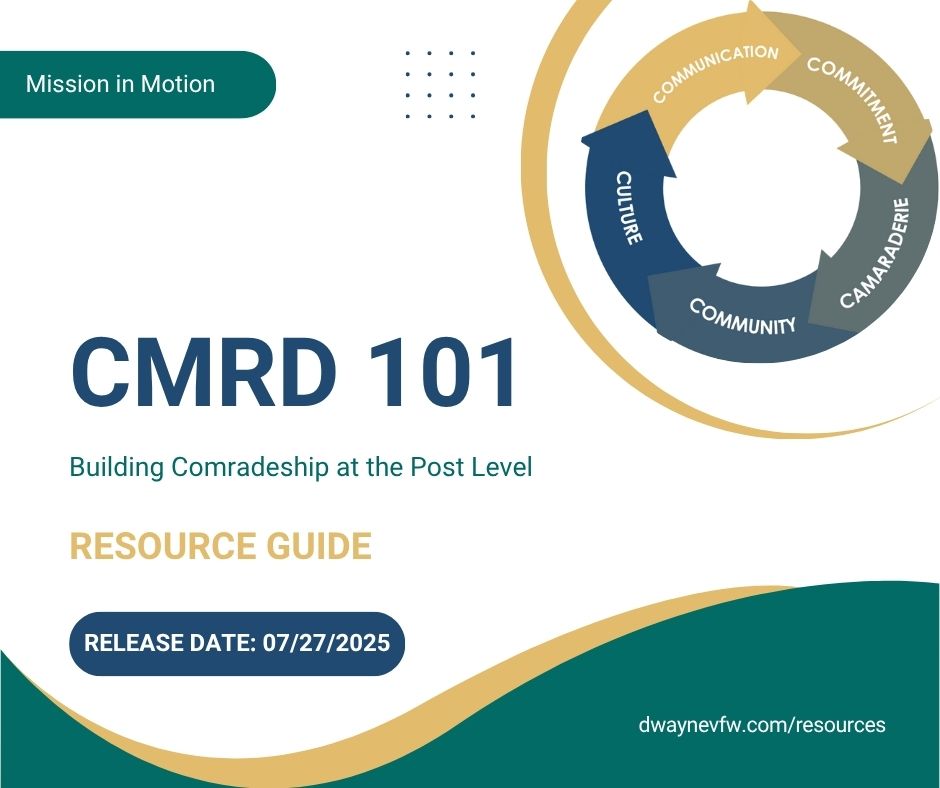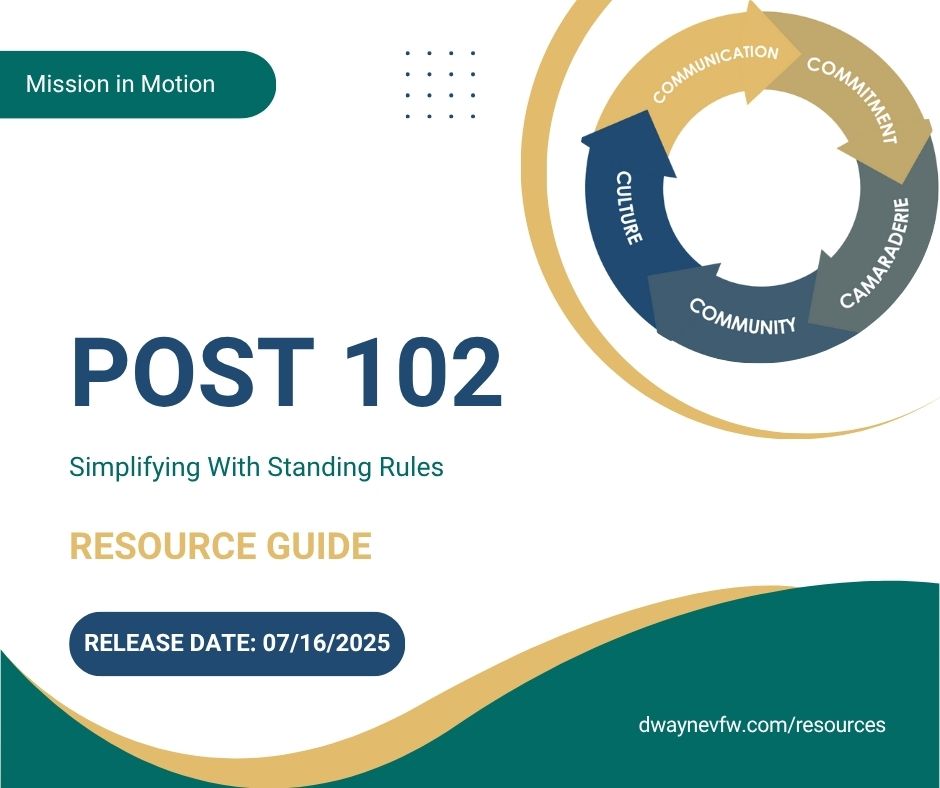In the Veterans of Foreign Wars (VFW), comradeship is more than a feel-good concept; it’s the heartbeat of a thriving Post. When veterans gather not just to fulfill their respective procedural duties, but further to support, uplift, and empower one another, something powerful happens. These comrades forge bonds rooted in shared experience, mutual respect, and an overall commitment to serving both one another and the greater veteran community. From cultivating a welcoming atmosphere to developing team-based traditions, building strong comradeship is foundational to recruitment, retention, morale, and mission success.
Why Comradeship Matters
The VFW was founded on shared service and sacrifice. But for many veterans, the greatest draw to joining a Post isn’t the obligatory paperwork or even the fraternal meetings; it’s the people. So, why is enhancing camaraderie so very important? Like on the battlefield, a sense of comradeship is SO impactful.
Comradeship promotes:
- Belonging: A sense of “coming home” where individuals are seen, heard, valued, and understood.
- Support: Emotional, moral, and at times, material help from those who’ve walked in similar boots along a similar path.
- Motivation: People are more likely to stay involved and step up when they feel connected.
- Post Pride: A Post with camaraderie isn’t just functional, it’s magnetic.
Building this bond doesn’t happen by accident. It takes intentional leadership, inclusive programming, and shared values in action.
Start with the Atmosphere: Make the Post Feel Like Home
Every comrade remembers their first time walking into a VFW Post. Whether that experience felt welcoming or intimidating shapes whether they come back. That first impression and the emotional connection made is directly impacts whether the veteran and his or her family fully engage or decide to drift away.
Tips for a More Inviting Post Environment:
- First Impressions Matter: Greet newcomers warmly. Introduce them by name to other veterans. Learn something about their service and see if you can make a connection with them or connect them with someone who has endured a similar experience.
- Create Comfort Zones: Seating areas that encourage conversation, photos that reflect all eras of service, and an overall tidy, cared-for space signal respect and inclusion. When the area is spacious and comfortable, veterans want to hang out there.
- Highlight Member Stories: Feature a “Comrade of the Month” or display bios of members on a community board to foster connection and visibility. Make sure they know who are the current Post leaders (by name), but every comrade counts, so spotlight great effort by those across the entire Post!
When your Post feels like a second home and not just a meeting place, you’re laying the foundation for stronger relationships. Your Post is building the experiences and environments for years to come.
Engage Through Shared Experiences
Veterans bond best through action, not obligation. Shared missions and moments, especially informal ones, cultivate true camaraderie. A Post that practices what it preaches is more successful.
Comradeship Builders That Work:
- Work Days with a Purpose: Organize Post improvement projects that end with a social hour. Sweat and laughter go hand-in-hand. Work hard – play hard!
- Buddy Systems: Pair up new members with seasoned ones for guidance and inclusion. This mentor and fellow comrade can provide so much for that new member on behalf of the VFW Post.
- Watch Parties or Game Nights: Build tradition around casual events. Consider adding periodic, recurring events everyone wants to be part of like UFC fights, military movies, or football games.
- Comrade-Centered Events: Birthdays, promotions, and homecomings are moments to celebrate. Celebrate the major holidays and Post festivities, but don’t forget that personal milestones matter, too – possibly more so.
- Outreach Teams: Assign small teams to visit homebound or hospitalized members. The act of checking in strengthens bonds. Consider this a Buddy Check Squad or fire team, akin to what many have experienced while serving in uniform.
Shared moments, big and small, form the threads that tie comrades together.
Lead by Example: Leadership and Camaraderie
Post leadership sets the tone. If officers only show up to gavel the meeting and leave, that distance becomes the norm. When leaders genuinely engage, listen, and invest in relationships, that spirit spreads. Lead with purpose and authenticity; if you fake it, your fellow comrades know, and that lends itself to a bad experience
Comradeship-Oriented Leadership Habits:
- Be Present: Attend informal events, not just business meetings.
- Be Approachable: Take time to chat with members before and after meetings.
- Be Supportive: Publicly acknowledge member contributions. Send a card when someone is ill. Show up for life events.
- Be Inclusive: Invite participation. Rotate roles and responsibilities. Encourage new ideas.
Camaraderie doesn’t start at the top, but it does radiate from it. Set a tone of humility, humor, and heart.
Celebrate Diversity in Service
Comradeship thrives when all feel equally valued. That means recognizing the diversity of the veteran experience: from combat theater deployments to domestic training, from enlisted to officer, male and female, young and seasoned. Some served four years and were honorably discharged while others might have made the military a twenty or thirty year career. Be mindful of the vast diversity that our military experiences brought and leverage that in a positive light when at the VFW Post.
Inclusion Strengthens Brotherhood and Sisterhood:
- Honor All Eras Equally: Ensure the Post isn’t centered on just one generation or war. Rotate historical spotlights or event themes.
- Bridge Generations: Host story-sharing nights where older and younger veterans swap experiences and lessons. There is a wealth of knowledge and opportunity of bringing multiple generations together.
- Acknowledge the Whole Person: Many veterans are also parents, caregivers, or working professionals. Make space for their lives beyond their DD-214.
Unity doesn’t mean uniformity. The richer the tapestry of your Post, the stronger the potential for meaningful connection.
Embrace Tradition, but Create New Ones
Longstanding traditions bring a sense of history and continuity, but don’t be afraid to start new ones. Camaraderie flourishes when members feel like they’re shaping their Post culture, not just inheriting it.
Blend Legacy with Innovation:
- Annual Rituals: Dinners, ceremonies, or memorial events that honor those who came before.
- Modern Milestones: Host a “Welcome Home BBQ” for each new member or a quarterly Comrade Challenge night with games and trivia. Think outside the box and try a few new things.
- Family-Friendly Events: Kids’ movie nights, community service projects, or joint events with the Auxiliary can expand your reach and deepen relationships and commitment.
New traditions signal that your Post is living, not static; every comrade has a role in its legacy.
Communication as a Tool for Connection
Camaraderie can’t thrive without consistent communication. It’s more than sending newsletters; it’s about building two-way relationships. Don’t just send a mass email and then think communications are covered. Engage the process and build upon the current communication methods that work best for your Post members.
Communication Best Practices:
- Check In, Don’t Just Check Boxes: Make personal calls, not just mass emails, and use those calls to reengage quieter members.
- Use Social Media as a Connector: Spotlight member achievements, Post events, and moments of joy, not just announcements or emergency messages.
- Monthly “Comrade Coffee”: Create open-door time for anyone to come share feedback, ideas, or concerns.
Strong camaraderie means everyone feels heard, not just informed.
Addressing Conflict with Respect
No Post is immune to disagreements, but how you handle conflict can either build or break comradeship. Work together to resolve differences, and don’t let them grow legs.
Tips for Conflict Resolution:
- Stay Mission-Focused: Remind members that disagreements shouldn’t derail shared goals.
- Create Safe Space for Discussion: Offer a neutral third party, like a Chaplain or Judge Advocate, for mediation.
- Focus on the ‘Why’: Remind each other of the reason you joined the Veterans of Foreign Wars – to serve, support, and uplift your fellow veteran.
Respect in disagreement preserves the bond even when opinions differ. Ensure all comrades feel empowered to share their voice, but work together to handle issues as they arise.
Measuring and Sustaining Comradeship
You can’t manage what you don’t measure. While camaraderie is a feeling, its impact shows in behavior.
Signs of Strong Comradeship:
- High event turnout
- Members attending even when they’re not signed up to volunteer
- Regular laughter and storytelling
- Members volunteering time to help one another
- Members volunteer for more events – repeat volunteers
- Strong retention and referrals from current members
Keep It Going:
- Conduct an annual survey to gauge consistency and enhanced camaraderie
- Appoint a “Morale Officer” or informal comrade connector to oversee the momentum trend
- Debrief after events to see what brought people together and ask all participants – volunteers and attendees to provide targeted feedback
Make comradeship a Post priority, not an afterthought.
Final Thoughts: Brotherhood and Beyond
At its core, the VFW isn’t about paperwork, points, or plaques— NO; it’s about people. It’s about the comrade who stays after the meeting to talk. It is about the quiet member who finds joy again in service and the new face who walks in and feels, for the first time, in a while, that they belong.
When comradeship thrives at the Post level, everything else follows. Events fill up. Volunteers step forward. Members stay and become more active. In the end, the mission of the VFW—advocacy, support, and community—moves forward with strength. Now is the time to make the improvements to your Post that your fellow comrades deserve. Be the comrade you wish you had when you first joined. Then, lead your Post to be that place for the next generation. Remember – you don’t have to be the Post Commander to participate in this movement; it takes all comrades within the Post to work together to make this happen.






